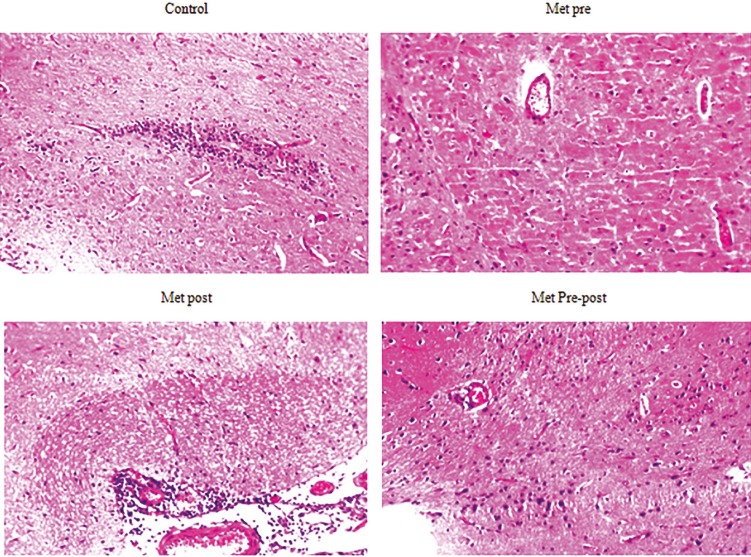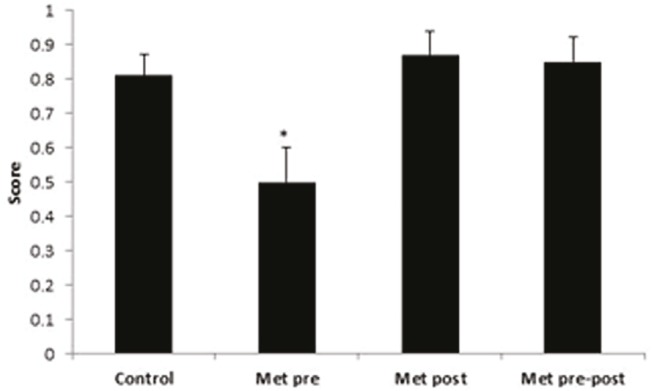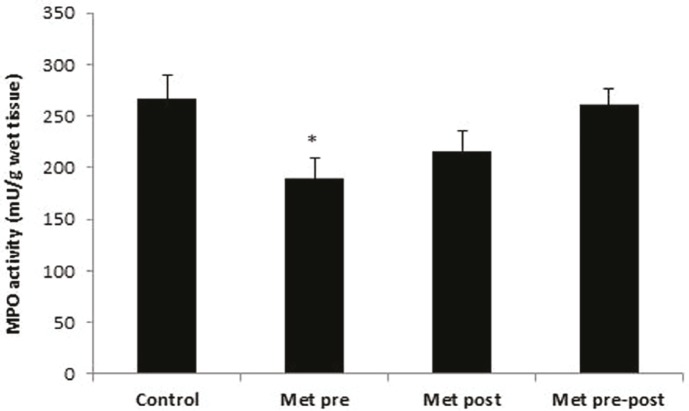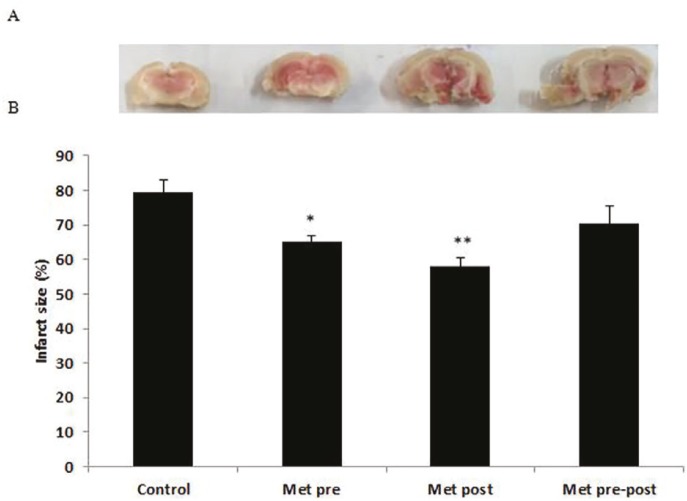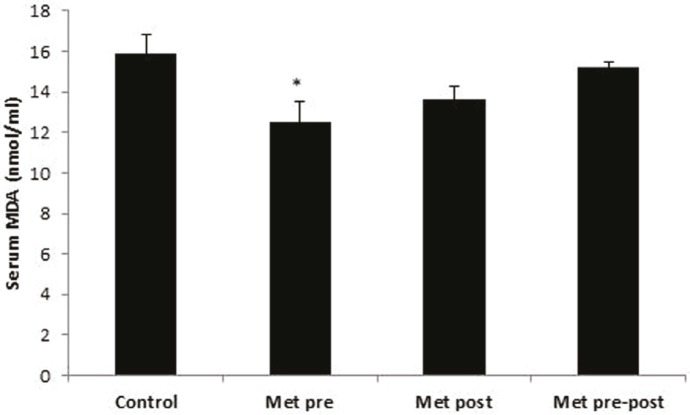Abstract
Objective:
To explore the effects of pre versus post ischemic treatment with metformin after global cerebral ischemia in rats.
Methods:
Male Wister rats underwent forebrain ischemia by bilateral common carotid artery occlusion for 17 min. Metformin (200 mg/kg) or vehicle was given orally by gavage for 7-14 days. Rats were divided into: control, metformin pre-treatment, metformin post-treatment and metformin pre and post continuous treatment groups. Cerebral infarct size, histopathology, myeloperoxidase and serum malondialdehyde were measured 7 days after ischemia.
Results:
Histopathological analysis showed that metformin pre-treatment significantly decreased leukocyte infiltration, myeloperoxidase activity and also malondialdehyde level. Metformin pre-treatment and metformin post-treatment reduced infarct size compared with the control group, but it was not significant in the pre and post continuous treatment group.
Conclusion:
Our findings suggest that pre-treatment with metformin in comparison with post-treatment in experimental stroke can reduce the extent of brain damage and is more neuroprotective at least in part by inhibiting oxidative stress and inflammation.
Key Words: Global cerebral ischemia, Metformin, Oxidative stress, Inflammation.
Introduction
Stroke is one of the common pathological conditions that threats public health worldwide and is responsible for approximately 9% of total deaths each year [1-4]. Based on World Health Organization data, 15 million people suffer from stroke. Stroke can be divided into ischemic and hemorrhagic types [5, 6].Ischemic stroke causes about 83% of all strokes and is the main leading cause of death and disability worldwide [7]. Global cerebral ischemia model is one of the experimental models that typically occur following cardiac arrest, shock, asphyxia and complex cardiac surgery [8]. Oxidative stress plays a major role in the pathogenesis of ischemia/ reperfusion (IR) injury in many organs including brain [9]. The brain contains high amounts of polyunsaturated lipids and high rate of oxidative metabolic activity. Therefore, it is one of the most important targets for free radical attacks that results in oxidative damage including lipid peroxidation, protein oxidation and DNA damage, which can lead to cell death [10,11]. There is no proven drug or pharmacologic agent to reduce neuronal injury after global cerebral ischemia in humans [12,13]. And now many scientists are investigating neuroprotective effects of various drugs to be used in humans. Metformin is introduced for the treatment of types 2 diabetes mellitus since 1960s. This drug is effective in treating diabetes by inhibition of intestinal glucose absorption and reduction of gluconeogenesis in the liver [14].
In recent years, many studies have shown that the effect of metformin are not entirely attributed to its antihyperglycemic effects and has other useful properties including favorable cardiovascular and cerebrovascular effects [15,16]. Other many previous studies have shown that metformin mitigated IR induced brain damage and has potent neuroprotective effects [17-19]. Metformin decreases blood-brain barrier disruption in mice after middle cerebral stroke [20-22]. Furthermore, it has been also reported that long-term treatment with metformin prior to stroke is neuroprotective [23]. A study demonstrated that metformin possesses antioxidant properties and improves the oxidative stress induced by global cerebral ischemia in rats [9]. Metformin also is able to act against apoptotic cell death in primary cortical neurons of cultured rats [24].
As mentioned above, pre-treatment with metformin alleviates detrimental effects of ischemia on brain morphology and functions. Little data available about neuroprotective of post-treatment of metformin following cerebral ischemia and also there is no report to compare the therapeutic effects of metformin pre and post treatment on cerebral ischemia. Therefore, the purpose of the present study was to investigate the difference in effects of metformin pre and post treatment in a rat model of global cerebral ischemia.
Materials and Methods
Animals
Healthy adult male Wistar rats weighting 230±20g were used in this study. Rats were housed in Animal House of Urmia University of Medical Sciences at a controlled ambient temperature of 23±2 ºC, with food and water available ad libitum under a 12-h light/12-h dark cycle. The present study was performed in accordance with the Guide for the Care and Use of Laboratory Animals of Urmia University of Medical Sciences.
Chemical reagents
Metformin was a generous gift from MahbanChemi Pharmaceutical Inc. (Tehran, Iran). Ketamine and Xylazine was from Alfasan company (The Netherlands). The other reagents were of a commercial analytical grade.
Experimental design
Forty adult male rats were used in the whole experiment. The rats were randomly divided into four groups and were gavaged orally with metformin (200mg/kg/day) or saline. Rats in group 1 (control) underwent on bilateral common carotid ligation for induction of cerebral ischemia and received saline. Rats in group 2 (Pre) received metformin (200 mg/kg/day) for 7 days before cerebral ischemia and then received saline for next 7 days. Rats in group 3 (Post), 7 days before cerebral ischemia received saline and then treated with metformin for next 7 days. Rats in group 4 (Pre-Post) within 7 days before and 7 days after ischemia treated with metformin. Grouping of the animals and time and dose of treatment were based on previous studies [25, 26].
Surgery procedure
The animals were anesthetized by aninjection of a mixture of ketamine (60 mg/kg, Alfasan, The Netherlands), xylazine (10 mg/kg), and then, placed in a supine position and a ventral midline skin incision was made from the lower mandible posterior to the sternum (~3 cm) to expose the right and left common carotid artery. Then, rats were subjected to 17 min of bilateral common carotid occlusion (with special clamp) [27].
Histopathological examination
For histopathological examination, 24 h after the last treatment the rats were anesthetized and after obtaining blood and sacrificing with ketamine overdose brains were quickly removed and fixed in 10% formalin. After embedding in paraffin, 5 µm sections were stained with hematoxylin and eosin (H&E). The profile and degree of leukocyte infiltration into the brain were evaluated in each section of the brain tissue using a morphometric point-counting procedure. Two trained person were quantified cerebral damages by scoring and given a number for each changes as follows: 1, 2, 3, and 4 for low, moderate (focal cerebral damage or small multifocal degeneration with slight degree neutrophil infiltration), high (extensive degeneration and/or diffuse neutrophil infiltration), and intensive (necrosis with diffuse neutrophil infiltration) pathological changes, respectively and then photographed under light microscopy [28,29].
Myeloperoxidase assay
Myeloperoxidase (MPO) activity assay was performed as described previously [30, 31] with minor modifications. Brain tissues were homogenized (IKA Hemogenizer, Staufen, Germany) in a solution containing 0.5% hexa-decyltrimethyl-ammonium bromide (HTAB) dissolved in 50 mM potassium phosphate buffer (pH 6). The samples were then centrifuged at 4500 rpm for 30 min at 4 °C. Then, samples were sonicated for 10 s, freeze-thawed three times with sonication between cycles. Suspensions were then centrifuged at 4500 rpm for 30 min. An aliquot of the supernatant (0.1 ml) or standard (Sigma, Germany) was mixed with 2.9 ml solution of 50 mM potassium phosphate buffer at pH 6 containing0.167 mg/ml of O-dianisidine hydrochloride and 0.0005% H2O2. After 5 min, the reaction was stopped with 0.1 ml of 1.2 M hydrochloric acid. The rate of change in absorbance at 460 nm was measured using a spectrophotometer (Cecil 9000, Cambridge, UK). MPO activity was expressed in milli unit (mU) per gram weight of wet tissue.
Infarct size measurement
On day 15th, brain samples were quickly removed and kept at −20°C for 15 min to make a proper section. Then slices of 2 mm thickness were cut and completely immersed in a 1% solution of 2,3,5 Triphenyltetrazolium chloride (TTC) for 30 min at a temperature of 37°C in a darkroom. After staining, brain slices were fixed with 4% paraformaldehyde. The stained sections were digitally photographed and measured using Image j software [32]. Normal areas stain red whereas infarcted areas remain pale.
Determination of malondialdehyde
Malondialdehyde (MDA) was measured as a marker of oxidative stress in serum after cerebral ischemia/ reperfusion using a method as previously described [33].
Results
Histopathological of brain
Histological sections revealed the infiltration of leukocyte in the brain tissue of control group (Figure 1). It was found that metformin pre-treatment significantly (p<0.05) reduced leukocyte infiltration after global cerebral ischemia as shown in Figure 2.
Fig. 1.
Photomicrographs of brain stained with H&E. Pre-treatment with metformin significantly reduced neutrophil accumulation. Met pre: Metformin pre-treatment; Met post: Metformin post-treatment; Met pre-post: Metformin pre and post treatrment.Arrows indicate leukocyte infiltration.
Fig. 2.
Grading of leukocyte infiltration in the brain tissues. MetPre: metformin pre-treatment; Met Post: metformin post-treatment; Met Pre-Post: metformin pre and post treatment. *p<0.05 vs control group.
Myeloperoxidase activity
Cerebral ischemia resulted in an increase in leukocyte infiltration into the brain tissue, as measured by an increase in MPO activity in the brain (Figure 3). The pre-treatment of the rats with metformin, which was started 7 days before ischemia, was found to reduce the enzyme activity in the brain tissue from 267±22mU/g wet tissue in control group to 189±20mU/g (p<0.05) in metformin pre-treated group (Figure 3).
Fig. 3.
The effect of metformin on brain MPO activity after cerebral ischemia. Met Pre: metformin pre-treatment; Met Post: metformin post-treatment; Met Pre-Post: metformin pre and post treatment. *P<0.05 vs control group.
Infarct size
The effect of metformin treatment on brain infarct size was measured by TTC staining. As shown in Figure 4A, there was a clear difference between viable tissue (a deep red) and injured tissue (pale colored). Metformin pre-treatment and metformin post-treatment significantly reduced infarct size as compared to control group (Figure 4B).
Fig. 4.
(A) Representative images of TTC stained sections of brain after brain ischemia (B) Bar graph shows analysis of infarct size. Metformin pre-treatment and post-treatment significantly reduced infarct size. Met Pre: metformin pre-treatment; Met Post: metformin post-treatment; Met Pre-Post: metformin pre and post treatment. *P<0.05, **P<0.01 vs control.
Malondialdehyde
It was found that metformin pre-treatment significantly (p<0.05) reduced serum MDA level after cerebral ischemia, as shown in Figure 5.
Fig. 5.
Levels of serum MDA after brain ischemia. Met Pre: metformin pre-treatment; Met Post: metformin post-treatment; Met Pre-Post: metformin pre and post treatment. *P<0.05 vs control group.
Discussion
In the present study, we showed that pre-ischemic administration of metformin reduced cerebral infarct size, MPO activity, leukocyte accumulation and also serum MDA level (Table 1).
Table 1.
Summary of results along with comparison between groups.
| Control | Pre-treatment | Post-treatment | Pre-post treatment | P value | |
|---|---|---|---|---|---|
| Neutrophil infiltration | 0.81±0.06 | 0.5±0.1a | 0.87±0.07 | 0.87±0.07 | 0.012 a |
| MPO activity | 267±22 | 189±20 a | 216±20 | 261±16 | 0.033 a |
| MDA level | 15.8±1 | 12.5±1 a | 13.6±0.7 | 15.2±0.3 | 0.038 a |
| Infarct size | 79.3±3.7 | 65±1.7 a | 58±2.5b | 70.3±5 | 0.038 a0.002b |
Treatment groups compared with control group using one way ANOVA with Student-Newman-Keuls post hoc test;
Data are expressed as mean ± sem.
Clamping of bilateral carotid arteries in rats is a common model of incomplete global cerebral ischemia that induces partial ischemia without affecting the circle of Willis but results in a 50% decrease in cerebral blood flow [34]. An important cause of death following cardiopulmonary resuscitation is global cerebral ischemia after cardiocirculatory arrest [35]. There is no drug which has been proven to decrease brain injury after global cerebral ischemia in humans [12,13]. However, if an agent could decrease the cerebral ischemic size or amend neurological signs after global cerebral ischemia, it would be effective for patients at risk of cerebral ischemia injury [36].
Metformin is a drug widely used for the treatment of type 2 diabetes mellitus, but recently, it has been well documented that metformin has neuroprotective role on cerebral IR. For example, Liu et al., [25] showed that metformin could promote focal angiogenesis and neurogenesis and reduce injury in mice after middle cerebral artery occlusion. Ashabi et al., [37] found that metformin pre-treatment is able to improve stroke signs in the rats with global cerebral ischemia. In another study, it has been reported that treatment with metformin 24h after stroke, decreases brain atrophy [22]. Results of our study provide evidence that neuroprotective effect of metformin in pre-ischemic oral administration is better in compared with post and continuous (pre and post) administration. To our knowledge, there is no report to compare the neuroprotective effect of metformin in different time of oral administration (pre, post and continuous pre-post) on global cerebral ischemia.
Regarding to pathophysiological of brain ischemia, several mechanisms are involved in inducing cell damage including, inflammation, apoptosis and oxidative stress. [38]. Neuroprotective effects of metformin in cerebral ischemia are mediated through multiple mechanisms in which several different pathways act closely with each other. There are reports proposed the protective role of metformin via activation the AMP activated protein kinase (AMPK) in neuronal, cardiac and renal cells under ischemic condition [39, 40]. AMPK has a pivotal role in regulating energy homeostasis and cell survival [41]. The role of AMPK in brain diseases such as ischemia, Alzheimer and Huntington`s is well known [42-44]. In previous studies, it has been documented that metformin through phosphorylation of AMPK causes downstream signaling pathways in neurons during oxidative stress and neurodegeneration [37,45]. Other reports demonstrated that AMPK is activated by metformin administration which in turn activates some pathway including, mitochondrial biogenesis, antioxidant enzymes and nuclear factor erythroid 2 related factor (Nrf2) [37,42].
In the current study, the MDA level, as an oxidative stress marker, was reduced significantly in the metformin pre-treatment group. This result is in accordance with the study indicating that metformin inhibits the production of free radicals [9]. Furthermore, it has been also reported that metformin reduces ROS levels by inducing antioxidant thioredoxin expression via activation of the AMPK [46]. Another mechanism that metformin exerts its antioxidant property and inhibits inflammatory responses is activation of nuclear factor erythroid 2 related factor (Nrf2) pathway through induction of AMPK following transient global cerebral ischemia model [42]. We demonstrated that pre-treatment with metformin for 7 days before cerebral ischemia, significantly decreased infarct size. This finding is consistent with other studies which used the chronic metformin administration [23] although acute pre-treatment (3 days) has been shown to increase injury in ischemic stroke [47].
Inflammation is one of important pathologic factor involved in brain damage in cerebral ischemia [48]. Nuclear factor kappa B (NF-KB) as a transcriptional regulator factor in inflammation is activated during brain ischemia and leads to production of pro-inflammatory cytokines such as tumor necrosis factor (TNF-α),interloukin (IL)-1β, IL6 and inducible nitric oxide synthase (iNOS) [49,50].
Pervious experimental studies in rodents showed that inhibition of NF-KB could decreased inflammation and improve brain ischemia outcome [51,52].
It has been documented that pre-treatment with metformin is able to decrease inflammation through suppression of NF-KB during acute phase of ischemic stroke [53].
To demonstrate the effects of metformin on neutrophil infiltration, we performed MPO assay 7 days after cerebral ischemia. Results showed that metformin pre-treatment reduced MPO activity. The mechanism by which metformin decreases an inflammatory response after cerebral ischemia is not fully understood. Metformin decreased ILβ, IL6 and TNFα expression in mice 3 days following middle cerebral artery occlusion [20]. Previous reports have shown that intercellular adhesion molecule1 (ICAM1) expression increases during reperfusion and leads to an increase in neutrophil adhesion to ECs and enhances their infiltration [40] and anti-ICAM1 decreases infarct size [54]. Liu et al., [20] showed that metformin reduced ICAM1 via the AMPK signaling pathway both in vivo and in vitro and this reduction in vivo was accompanied by alleviated leukocyte infiltration and reduced infarct size in mice after middle cerebral artery occlusion. Thus, it has been concluded that metformin exerts its neuroprotective effects following cerebral ischemia partly through decreased ICAM1 expression.
Like other studies, our project has some limitations. For example: the pro-inflammatory cytokines levels, activity of antioxidant enzymes and AMPK expression were not measured. Evaluating each of them could help in understanding the protective mechanisms of metformin against cerebral ischemia. In our study the animals were euthanized 7 days after brain ischemia and long-term effects of metformin administration were not evaluated.
In conclusion our study showed that metformin pre-treatment in comparison to post and pre-post treatment, reduced significantly cerebral ischemia induced injuries at least in part through its anti-inflammatory and antioxidant effects.
Acknowledgment
This study was financially supported by Urmia University of Medical Sciences.
Conflict of Interest:
The authors declare that there are no conflicts of interest.
References
- 1.Saiki R, Park H, Ishii I, Yoshida M, Nishimura K, Toida T, et al. Brain infarction correlates more closely with acrolein than with reactive oxygen species. Biochem Biophys Res Commun. 2011;404(4):1044–9. doi: 10.1016/j.bbrc.2010.12.107. [DOI] [PubMed] [Google Scholar]
- 2.Sarkaki A, Farbood Y, Badavi M, Khalaj L, Khodagholi F, Ashabi G. Metformin improves anxiety-like behaviors through AMPK-dependent regulation of autophagy following transient forebrain ischemia. Metab Brain Dis. 2015;30(5):1139–50. doi: 10.1007/s11011-015-9677-x. [DOI] [PubMed] [Google Scholar]
- 3.Strong K, Mathers C, Bonita R. Preventing stroke: saving lives around the world. Lancet Neurol. 2007;6(2):182–7. doi: 10.1016/S1474-4422(07)70031-5. [DOI] [PubMed] [Google Scholar]
- 4.Meyers PM, Schumacher HC, Alexander MJ, Derdeyn CP, Furlan AJ, Higashida RT, et al. Performance and training standards for endovascular acute ischemic stroke treatment. Neurology. 2012;79(13 Suppl 1):S234–8. doi: 10.1212/WNL.0b013e318269595b. [DOI] [PubMed] [Google Scholar]
- 5.Paul SL, Srikanth VK, Thrift AG. The large and growing burden of stroke. Curr Drug Targets. 2007;8(7):786–93. doi: 10.2174/138945007781077418. [DOI] [PubMed] [Google Scholar]
- 6.Taylor TN, Davis PH, Torner JC, Holmes J, Meyer JW, Jacobson MF. Lifetime cost of stroke in the United States. Stroke. 1996;27(9):1459–66. doi: 10.1161/01.str.27.9.1459. [DOI] [PubMed] [Google Scholar]
- 7.Li J, Zeng Z, Viollet B, Ronnett GV, McCullough LD. Neuroprotective effects of adenosine monophosphate-activated protein kinase inhibition and gene deletion in stroke. Stroke. 2007;38(11):2992–9. doi: 10.1161/STROKEAHA.107.490904. [DOI] [PMC free article] [PubMed] [Google Scholar]
- 8.Harukuni I, Bhardwaj A. Mechanisms of brain injury after global cerebral ischemia. Neurol Clin. 2006;24(1):1–21. doi: 10.1016/j.ncl.2005.10.004. [DOI] [PubMed] [Google Scholar]
- 9.Abd-Elsameea A, Moustaf A, Mohamed A. Modulation of the oxidative stress by metformin in the cerebrum of rats exposed to global cerebral ischemia and ischemia/reperfusion. Eur Rev Med Pharmacol Sci. 2014;18(16):2387–92. [PubMed] [Google Scholar]
- 10.Floyd RA. Antioxidants, oxidative stress, and degenerative neurological disorders. Proc Soc Exp Biol Med. 1999;222(3):236–45. doi: 10.1046/j.1525-1373.1999.d01-140.x. [DOI] [PubMed] [Google Scholar]
- 11.Yuan J, Yankner BA. Apoptosis in the nervous system. Nature. 2000;407(6805):802–9. doi: 10.1038/35037739. [DOI] [PubMed] [Google Scholar]
- 12.Baughman VL, Hoffman WE, Miletich DJ, Albrecht RF, Thomas C. Neurologic outcome in rats following incomplete cerebral ischemia during halothane, isoflurane, or N2O. Anesthesiology. 1988;69(2):192–8. doi: 10.1097/00000542-198808000-00007. [DOI] [PubMed] [Google Scholar]
- 13.Kimbro JR, Kelly PJ, Drummond JC, Cole DJ, Patel PM. Isoflurane and pentobarbital reduce AMPA toxicity in vivo in the rat cerebral cortex. Anesthesiology. 2000;92(3):806–12. doi: 10.1097/00000542-200003000-00024. [DOI] [PubMed] [Google Scholar]
- 14.Martin-Montalvo A, Mercken EM, Mitchell SJ, Palacios HH, Mote PL, Scheibye-Knudsen M, et al. Metformin improves healthspan and lifespan in mice. Nat Commun. 2013;4:2192. doi: 10.1038/ncomms3192. [DOI] [PMC free article] [PubMed] [Google Scholar]
- 15.Roussel R, Travert F, Pasquet B, Wilson P, Smith SC Jr, Goto S. Metformin use and mortality among patients with diabetes and atherothrombosis. Arch Intern Med. 2010;170(21):1892–9. doi: 10.1001/archinternmed.2010.409. [DOI] [PubMed] [Google Scholar]
- 16.Zimmet P, Collier G. Clinical efficacy of metformin against insulin resistance parameters: sinking the iceberg. Drugs. 1999;58 (Suppl 1):21–8. doi: 10.2165/00003495-199958001-00007. discussion 75-82. [DOI] [PubMed] [Google Scholar]
- 17.Ge XH, Zhu GJ, Geng DQ, Zhang HZ, He JM, Guo AZ, et al. Metformin protects the brain against ischemia/reperfusion injury through PI3K/Akt1/JNK3 signaling pathways in rats. Physiol Behav. 2017;170:115–123. doi: 10.1016/j.physbeh.2016.12.021. [DOI] [PubMed] [Google Scholar]
- 18.Guo JM, Zhang L, Niu XC, Shu H, Wang L, Su DF, et al. Involvement of arterial baroreflex and nicotinic acetylcholine receptor α7 subunit pathway in the protection of metformin against stroke in stroke-prone spontaneously hypertensive rats. Eur J Pharmacol. 2017;798:1–8. doi: 10.1016/j.ejphar.2017.01.035. [DOI] [PubMed] [Google Scholar]
- 19.Deng T, Zheng YR, Hou WW, Yuan Y, Shen Z, Wu XL, et al. Pre-stroke metformin treatment is neuroprotective involving AMPK reduction. Neurochem Res. 2016;41(10):2719–27. doi: 10.1007/s11064-016-1988-8. [DOI] [PubMed] [Google Scholar]
- 20.Liu Y, Tang G, Li Y, Wang Y, Chen X, Gu X, et al. Metformin attenuates blood-brain barrier disruption in mice following middle cerebral artery occlusion. J Neuroinflammation. 2014;11:177. doi: 10.1186/s12974-014-0177-4. [DOI] [PMC free article] [PubMed] [Google Scholar]
- 21.Wang J, Gallagher D, DeVito LM, Cancino GI, Tsui D, He L, et al. Metformin activates an atypical PKC-CBP pathway to promote neurogenesis and enhance spatial memory formation. Cell Stem Cell. 2012;11(1):23–35. doi: 10.1016/j.stem.2012.03.016. [DOI] [PubMed] [Google Scholar]
- 22.Venna VR, Li J, Hammond MD, Mancini NS, McCullough LD. Chronic metformin treatment improves post‐stroke angiogenesis and recovery after experimental stroke. Eur J Neurosci. 2014;39(12):2129–38. doi: 10.1111/ejn.12556. [DOI] [PMC free article] [PubMed] [Google Scholar]
- 23.Li J, Benashski SE, Venna VR, McCullough LD. Effects of metformin in experimental stroke. Stroke. 2010;41(11):2645–52. doi: 10.1161/STROKEAHA.110.589697. [DOI] [PMC free article] [PubMed] [Google Scholar]
- 24.El-Mir M-Y, Detaille D, Gloria R, Delgado-Esteban M, Guigas B, Attia S, et al. Neuroprotective role of antidiabetic drug metformin against apoptotic cell death in primary cortical neurons. J Mol Neurosci. 2008;34(1):77–87. doi: 10.1007/s12031-007-9002-1. [DOI] [PubMed] [Google Scholar]
- 25.Liu Y, Tang G, Zhang Z, Wang Y, Yang GY. Metformin promotes focal angiogenesis and neurogenesis in mice following middle cerebral artery occlusion. Neurosci Lett. 2014;579:46–51. doi: 10.1016/j.neulet.2014.07.006. [DOI] [PubMed] [Google Scholar]
- 26.Saito T, Nito C, Ueda M, Inaba T, Kamiya F, Muraga K, et al. Continuous oral administration of atorvastatin ameliorates brain damage after transient focal ischemia in rats. Life Sci. 2014;94(2):106–14. doi: 10.1016/j.lfs.2013.11.018. [DOI] [PubMed] [Google Scholar]
- 27.Zamani M, Soleimani M, Golab F, Mohamadzadeh F, Mehdizadeh M, Katebi M. NeuroProtective effects of adenosine receptor agonist coadministration with ascorbic acid on CA1 hippocampus in a mouse model of ischemia reperfusion injury. Metab Brain Dis. 2013;28(3):367–74. doi: 10.1007/s11011-013-9408-0. [DOI] [PubMed] [Google Scholar]
- 28.Soraya H, Khorrami A, Garjani A, Maleki-Dizaji N, Garjani A. Acute treatment with metformin improves cardiac function following isoproterenol induced myocardial infarction in rats. Pharmacol Rep. 2012;64(6):1476–84. doi: 10.1016/s1734-1140(12)70945-3. [DOI] [PubMed] [Google Scholar]
- 29.Matsuo Y, Onodera H, Shiga Y, Nakamura M, Ninomiya M, Kihara T, et al. Correlation between myeloperoxidase-quantified neutrophil accumulation and ischemic brain injury in the rat Effects of neutrophil depletion. Stroke. 1994;25(7):1469–75. doi: 10.1161/01.str.25.7.1469. [DOI] [PubMed] [Google Scholar]
- 30.Safaeian L, Tameh AA, Ghannadi A, Naghani EA, Tavazoei H, Alavi SS. Protective effects of Echium amoenum Fisch and CA Mey against cerebral ischemia in the rats. Advanced biomedical research. 2015;4:107. doi: 10.4103/2277-9175.157809. [DOI] [PMC free article] [PubMed] [Google Scholar]
- 31.Bradley PP, Priebat DA, Christensen RD, Rothstein G. Measurement of cutaneous inflammation: estimation of neutrophil content with an enzyme marker. J Invest Dermatol. 1982;78(3):206–9. doi: 10.1111/1523-1747.ep12506462. [DOI] [PubMed] [Google Scholar]
- 32.Kamat PK, Kalani A, Metreveli N, Tyagi SC, Tyagi N. A possible molecular mechanism of hearing loss during cerebral ischemia in mice. Can J Physiol Pharmacol. 2015;93(7):505–16. doi: 10.1139/cjpp-2014-0489. [DOI] [PMC free article] [PubMed] [Google Scholar]
- 33.Satoh K. Serum lipid peroxide in cerebrovascular disorders determined by a new colorimetric method. Clin Chim Acta. 1978;90(1):37–43. doi: 10.1016/0009-8981(78)90081-5. [DOI] [PubMed] [Google Scholar]
- 34.Eklöf B, Siesjö BK. The effect of bilateral carotid artery ligation upon the blood flow and the energy state of the rat brain. Acta Physiol Scand. 1972;86(2):155–65. doi: 10.1111/j.1748-1716.1972.tb05322.x. [DOI] [PubMed] [Google Scholar]
- 35.Schneider A, Böttiger BW, Popp E. Cerebral resuscitation after cardiocirculatory arrest. Anesth Analg. 2009;108(3):971–9. doi: 10.1213/ane.0b013e318193ca99. [DOI] [PubMed] [Google Scholar]
- 36.Jung YS, Oh AY, Park HP, Hwang JW, Lim YJ, Jeon YT. Post-ischemic administration of pravastatin reduces neuronal injury by inhibiting Bax protein expression after transient forebrain ischemia in rats. Neurosci Lett. 2015;594:87–92. doi: 10.1016/j.neulet.2015.03.038. [DOI] [PubMed] [Google Scholar]
- 37.Ashabi G, Khodagholi F, Khalaj L, Goudarzvand M, Nasiri M. Activation of AMP-activated protein kinase by metformin protects against global cerebral ischemia in male rats: Interference of AMPK/PGC-1α pathway. Metab Brain Dis. 2014;29(1):47–58. doi: 10.1007/s11011-013-9475-2. [DOI] [PubMed] [Google Scholar]
- 38.Bramlett HM, Dietrich WD. Pathophysiology of cerebral ischemia and brain trauma: similarities and differences. J Cereb Blood Flow Metab. 2004;24(2):133–50. doi: 10.1097/01.WCB.0000111614.19196.04. [DOI] [PubMed] [Google Scholar]
- 39.Ghadernezhad N, Khalaj L, Pazoki-Toroudi H, Mirmasoumi M, Ashabi G. Metformin pretreatment enhanced learning and memory in cerebral forebrain ischaemia: the role of the AMPK/BDNF/P70SK signalling pathway. Pharm Biol. 2016;54(10):2211–9. doi: 10.3109/13880209.2016.1150306. [DOI] [PubMed] [Google Scholar]
- 40.Ashabi G, Sarkaki A, Khodagholi F, Zareh Shahamati S, Goudarzvand M, Farbood Y, et al. Subchronic metformin pretreatment enhances novel object recognition memory task in forebrain ischemia: behavioural, molecular, and electrophysiological studies. Can J Physiol Pharmacol. 2017;95(4):388–395. doi: 10.1139/cjpp-2016-0260. [DOI] [PubMed] [Google Scholar]
- 41.Polels J, Spasic MR, Callaaerts P, Norga KK. Expanding roles for AMP-activated protein kinase in neuronal survival and autophagy. Bioessays. 2009;31(9):944–59. doi: 10.1002/bies.200900003. [DOI] [PubMed] [Google Scholar]
- 42.Ashabi G, Khalaj L, Khodagholi F, Goudarzvand M, Sarkaki A. Pre-treatment with metformin activates Nrf2 antioxidant pathways and inhibits inflammatory responses through induction of AMPK after transient global cerebral ischemia. Metab Brain Dis. 2015;30(3):747–54. doi: 10.1007/s11011-014-9632-2. [DOI] [PubMed] [Google Scholar]
- 43.Khang R, Park C, Shin JH. The biguanide metformin alters phosphoproteomic profiling in mouse brain. Neurosci Lett. 2014;579:145–50. doi: 10.1016/j.neulet.2014.07.029. [DOI] [PubMed] [Google Scholar]
- 44.Ma TC, Buescher JL, Oatis B, Funk JA, Nash AJ Carrier RL, et al. Metformin therapy in a trasnsgenic mouse model of Huntington`s disease. Neurosci Lett. 2007;411(2):98–103. doi: 10.1016/j.neulet.2006.10.039. [DOI] [PubMed] [Google Scholar]
- 45.Pintana H, Apaijai N, Pratchayasakul W, Chattipakom N, Chattipakom SC. Effects of metformin on learning and memory behaviors and brain mitochondrial functions in high fat diet induced insulin resistant rats. Life Sci. 2012;91(11-12):409–414. doi: 10.1016/j.lfs.2012.08.017. [DOI] [PubMed] [Google Scholar]
- 46.Hou X, Song J, Li XN, Zhang L, Wang X, Chen L, et al. Metformin reduces intracellular reactive oxygen species levels by upregulating expression of the antioxidant thioredoxin via the AMPK-FOXO3 pathway. Biochem Biophys Res Commun. 2010;396(2):199–205. doi: 10.1016/j.bbrc.2010.04.017. [DOI] [PubMed] [Google Scholar]
- 47.Harada S, Fujita-Hamabe W, Tokuyama S. The importance of regulation of blood glucose levels through activation of peripheral 5′-AMP-activated protein kinase on ischemic neuronal damage. Brain Res. 2010;1351:254–63. doi: 10.1016/j.brainres.2010.06.052. [DOI] [PubMed] [Google Scholar]
- 48.del Zoppo GJ. Acute anti-inflammatory approaches to ischemic stroke. Ann N Y Acad Sci. 2010;1207:143–8. doi: 10.1111/j.1749-6632.2010.05761.x. [DOI] [PMC free article] [PubMed] [Google Scholar]
- 49.Nurmi A, Lindsberg PJ, Koistinaho M, Zhang W, Juettler E, Karjalainen-Lindsberg ML, et al. Nuclear factor-kappaB contributes to infarction after permanent focal ischemia. Stroke. 2004;35(4):987–91. doi: 10.1161/01.STR.0000120732.45951.26. [DOI] [PubMed] [Google Scholar]
- 50.Kunz A, Abe T, Hochrainer K, Shimamura M, Anrather J, Racchumi G, et al. Nuclear factor-kappaB activation and postischemic inflammation are suppressed in CD36-null mice after middle cerebral artery occlusion. J Neurosci. 2008;28(7):1649–58. doi: 10.1523/JNEUROSCI.5205-07.2008. [DOI] [PMC free article] [PubMed] [Google Scholar]
- 51.Jiang T, Gao L, Guo J, Lu J, Wang Y, Zhang Y. Suppressing inflammation by inhibiting the NF-κB pathway contributes to the neuroprotective effect of angiotensin-(1-7) in rats with permanent cerebral ischaemia. Br J Pharmacol. 2012;167(7):1520–32. doi: 10.1111/j.1476-5381.2012.02105.x. [DOI] [PMC free article] [PubMed] [Google Scholar]
- 52.Desai A1, Singh N, Raghubir R. Neuroprotective potential of the NF-κB inhibitor peptide IKK-NBD in cerebral ischemia-reperfusion injury. Neurochem Int. 2010;57(8):876–83. doi: 10.1016/j.neuint.2010.09.006. [DOI] [PubMed] [Google Scholar]
- 53.Zhu XC1, Jiang T, Zhang QQ, Cao L, Tan MS, Wang HF, et al. Chronic Metformin Preconditioning Provides Neuroprotection via Suppression of NF-κB-Mediated Inflammatory Pathway in Rats with Permanent Cerebral Ischemia. Mol Neurobiol. 2015;52(1):375–85. doi: 10.1007/s12035-014-8866-7. [DOI] [PubMed] [Google Scholar]
- 54.Chopp M, Li Y, Jiang N, Zhang RL, Prostak J. Antibodies against adhesion molecules reduce apoptosis after transient middle cerebral artery occlusion in rat brain. J Cereb Blood Flow Metab. 1996;16(4):578–84. doi: 10.1097/00004647-199607000-00007. [DOI] [PubMed] [Google Scholar]



